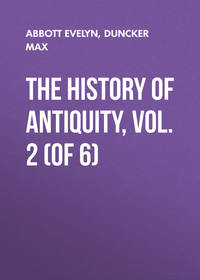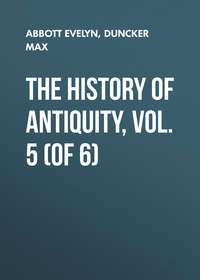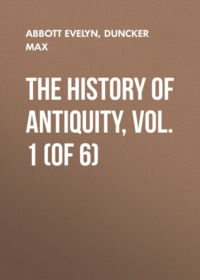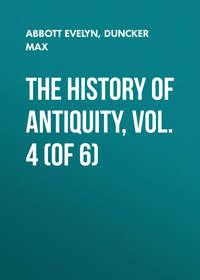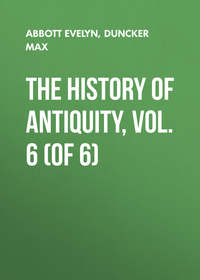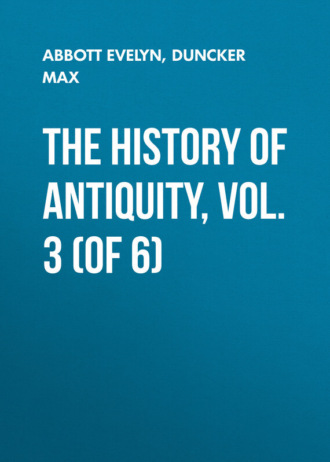 полная версия
полная версияThe History of Antiquity, Vol. 3 (of 6)
According to Herodotus, the Sarmatians and the Scoloti spoke the same language, but the Sarmatians spoke it badly. Beyond this remark and the statements about the masculine life of the Sarmatian women, he gives us no further information about this people. But he speaks at greater length about the Scoloti. The nature of the steppes which they possessed did not allow them to lead a more settled life than the Sarmatians. It is true that in the spring the herbage grows luxuriantly on these steppes, but it is soon parched by the glow of summer, and after a scanty second growth in the autumn it succumbs to the snow storms of the long winter. Thus the Scoloti were induced to lead a wandering pastoral life. Yet they had passed beyond the stage of a purely nomadic life, at least after the year 700 B.C. If, according to the legend of the Scoloti, a golden plough fell down from heaven for their forefathers, the story proves not only the knowledge of agriculture, but the high value placed upon it. The account of Herodotus, as well as later statements of the Greeks, show us that the Scoloti cultivated the land in the depressions at the mouths of their rivers sheltered by strips of forest from the north wind, on the lower course and at the mouths of the Borysthenes (Dnieper), the Hypanis (Bug), and the Tyras (Dniester). Here they sowed corn, millet, and hemp. At that time the plains of the Crimea also were reckoned as part of the corn land of Scythia; they must therefore have been protected by forests against the storms of the north.480 The property of the Scoloti, with the exception of the tillers of the soil in these districts, consisted in herds of horses and cattle, and flocks of sheep, from the wool of which they prepared felt coverings; their food was cooked flesh.481 Of wood there was such a scarcity that they could only use brush-wood for cooking; and if this was not to be had, they took the bones of animals for fuel. The men were mostly on horseback; the women and children lived in waggons yoked with oxen;482 the waggon, provided with a cover of felt, was at the same time tent and house.483 The clothing of the Scoloti consisted of skins; beside the upper garment of leather they had wide breeches of the same material. These garments, so astonishing to the Greeks, they wore, as Herodotus says, "on account of the cold," and in addition a girdle round the body, which they drew tight when they had had nothing to eat for a long time. The horse was the most important animal for the Scoloti; they lived in part on horse-flesh; they were fond of mare's milk, and the preparation of acidulated mare's milk (koumyss) was known to them.484
The nation was made up of a number of tribes. According to Herodotus, the land was divided into cantons, each of which had its own chief, and a place where he pronounced justice; in each canton, besides the residence of the chief, was a place sacred to the god of war, from which it follows that at the time presupposed in the description of Herodotus the tribes of the Scoloti no longer marched at will through the whole district. This original state was not merely abandoned owing to the settlements in the agricultural districts; even the habit of wandering up and down, the search for pasture and for water, and hunting, were limited among the migratory tribes to a particular district, within which the tribe changed its encampment according to the change of the seasons, and the productiveness of the hunting and pasturage. Moreover, the nomadic habit was also so far abandoned that the head of the tribe had a definite place of abode in the canton, and there was a sacred place in each canton. The rulers of the cantons in Herodotus were undoubtedly the princes of the tribes, the chiefs of the oldest family, or of the family which once ruled the tribe. Even among the tribes themselves there was an order of precedence, which the legend of the Scoloti does not carry back to difference of age but to the favour of heaven. The tribe which held the foremost place among the Scoloti was, according to Herodotus, the tribe called the "Royal Scythians." This tribe furnished the chief of the whole nation, or rather the chief of this tribe was also the ruler of all the other tribes – the king of all the princes of the tribes. Here also, in this subordination of the chieftains and tribes under one liege lord – in this one ruler of the whole nation – we see plainly that the Scoloti had left far behind the stage of purely nomadic life. We can establish it as a fact that this monarchy was in existence among the Scoloti in the first half of the seventh century B.C., and apparently it existed far earlier. The "Royal Scythians," i. e. the tribe to which the royal house belonged, dwelt, according to the statement of Herodotus, on the Borysthenes, in the district of Gerrhus, fourteen days' journey from the mouth of this river. Hence the pastures of the royal horde must be sought on the rapids of the Dnieper.
Before all gods, the Scoloti worshipped the sky-god, Papæus, and Hestia, i. e. the genius of the hearth, whom they called Tabiti, "the queen of the Scoloti," as Herodotus says; and beside these two, the god of light, Œtosyrus, and the earth-goddess, the spouse of the sky-god, who was called Apia.485 The Scoloti had no images or altars. Only the war-god, to whom they offered more sacrifices than to all the rest of the gods, had a sanctuary at the place of assembly for each canton. This was a great heap of bundles of brushwood, three stades in length and breadth, and flat on the top (each year 150 waggon-loads of brushwood were added), in which an iron sword – the symbol of the god – stood erect. To these swords sacrifices were offered yearly, chiefly of horses, though other animals were used. When the Scythians sacrificed their prisoners to the war-god (p. 239), they poured wine on their heads, and slew them at the base of the heap of brushwood, so that the blood ran into a skin, and the blood was then poured upon the erect sword. After this the right arm was hewn from the corpse of the victim and thrown into the air; it was allowed to remain where it fell.486
The Scoloti derived the origin of their nation from the gods – from Papæus, the god of the sky. This god begot Targitæus with the daughter of the river Borysthenes. Targitæus had three sons, Lipoxais, Arpoxais, and Colaxais. In their days a golden cup, a golden battle-axe, a golden yoke, and a golden plough fell down from heaven. When Lipoxais attempted to take the gold it burned; and in the same manner it escaped Arpoxais. But the youngest brother was able to take it. So he became king, and from him arose the royal tribe; from the two others sprang the other tribes.487 These gifts of heaven were carefully guarded by the kings, and each year the Scoloti assembled to offer sacrifices to them. The supreme power was hereditary in the family of Colaxais, who was nearest to the sky-god. The son succeeded to the father; but the people, if discontented with the king, chose another member of the same family.488 The kings led the army in war, divided the booty, and were the supreme judges in peace.489 If a king pronounced sentence of death, not only was the guilty man put to death, but all his family with him.490 But if a Scolote was condemned to death on the accusation of another Scolote, the king handed over the condemned person to the complainant, who put him to death. The kings had several wives, and chose whom they would out of the free Scoloti to be their servants. They had cooks, butlers, overseers of their horses, messengers, and a body-guard.491 If the king was sick, the Scoloti believed that some one among the people had sworn falsely by the spirit of the hearth of the king, which was their most sacred oath, and that this was the cause of the king's sickness.492 The king then caused the three most famous soothsayers to come to him, of whom there were many among the Scoloti. They divined by separating bundles of withes, or by unrolling and rolling up strips of linden bark. Then the three soothsayers named to the king the man who had taken the false oath. If six other soothsayers were of the same opinion, the Scolote mentioned by the first was beheaded. If the six were of a different opinion, fresh soothsayers were examined; and if, in the end, the majority declared against the opinion of the three first, these were bound and placed on a waggon filled with brushwood and yoked with oxen; the brushwood was set on fire, and the oxen driven out into the open country.
If the king died, his body was embalmed, and carried round through all the hordes. At all the places to which the body came, the Scoloti shaved off their hair in sign of mourning, and cut out a piece from the ear. They also wounded themselves in the brow and the nose, and pushed an arrow through the left hand. Then, in the land of Gerrhus, the district of the royal tribe on the Borysthenes, a great square sepulchre was excavated, and the dead king placed in the bottom of it, on a bed of brushwood. Lances were thrust into the ground close at hand, and wicker-work placed upon them. One of the wives of the king, his master of the horse, his butler, cook, body-servant, and herald were strangled, and their corpses placed in the grave beside the corpse of the king. The horses of the king also were killed, and thrown with other equipments into the grave. Then the grave was filled up, and a tumulus raised above it to as great a height as possible. But after a year's interval fifty young servants were selected from the retinue of the dead, and fifty horses of the king. These were killed in order to serve as guardians round the tomb of the king. When the soft parts had been removed from the bodies of the horses, and replaced by chaff, the carcases were set upright by means of poles driven into the earth. In the same way the dead youths were fixed upon the horses by poles thrust through the spine.493
With the Scoloti war was the most honourable occupation; those who pursued a handicraft were not held in such respect as the rest;494 the wealthier men had numerous slaves to look after their flocks, and do the work in their tents. The Scoloti usually fought as bowmen on horseback. Their bows were of peculiar form and curvature;495 the copper points of their arrows are said to have been poisoned;496 beside the bow they carried a battle-axe, sabre, dagger, and lance, with a whip.497 Their corslets and shields are said to have been made of elk's skin. "No man escapes them," Herodotus says; "and no man can overtake them and bring them to hand-conflict, if they do not wish to be overtaken, and their rivers help them." When a Scolote slays an enemy for the first time, he drinks of his blood;498 he who has slain no enemy receives no wine at the banquet which the chief of the canton gives once in each year, but must sit neglected in a corner; he who has slain many enemies, drinks out of two goblets at once.499 The Scoloti take the scalps from their slain enemies and hang them on the bridles of the horses, and he who has most of these scalps passes for the bravest. Some take the skins from the dead, and make of them covers for their quivers. Any one who would have a share in the booty must bring to the king the heads of the enemies he has slain.500 They sacrifice every hundredth man among the prisoners, and keep the rest as slaves. If a Scolote has a quarrel with another, and receives him from the king to put to death, he preserves his skull, even though he may be a near relation. The poorer people cover these skulls with ox-hide; the wealthier have them gilded, and use them as drinking-vessels: if a stranger comes among them, they exhibit these skulls, and boast of them.501
According to this description the Scoloti were a people, who, by the pursuit of agriculture at the mouths of their rivers, by some handicraft, by dividing the land into cantons, by fixing sacred places in the cantons, and by a monarchy governing all the tribes, had advanced beyond the nomadic stage. Hardened by life in the steppes, accustomed to bear hardships, and content with little, the Scoloti are excellent riders, and soldiers of great endurance. The picture which Herodotus has given of their manners displays a certain carelessness, kindliness, and sociability, but these qualities are accompanied by traits of horrid barbarism, cruelty, and blood-thirstiness. They can endure hunger and thirst; they take pleasure in banquets and drinking. The head of the tribe assembles his tribe each year for a feast, at which the brave men drink out of two goblets at once. The nearest relatives place the body of the dead on a waggon, and carry it round among their friends, each of whom provides a banquet, at which food is placed for the dead as well as for the living. When forty days have been spent in this manner, the dead person is buried.502 When the Hellenes introduced wine among the Scyths – the introduction perhaps took place after the beginning of the seventh century – men and women drank immoderately of it beside their mare's milk, and became violently intoxicated.503 They also lived in great uncleanliness. The want of water in their steppes made cleanliness difficult, but that was no reason for never washing themselves at all, which Herodotus tells us was the habit of the Scoloti. Only the wealthier sort among the Scoloti had more than one wife; the women were without rights, and belonged to their husbands in just the same way as any head of their cattle: this right of property in the wife even descended to the sons, who had an hereditary claim and right to their mothers. The execution of the family along with the guilty person; the blinding of slaves, which certainly cannot have been so widely spread as Herodotus maintains; the use of scalps for ornaments; and the custom of drinking out of the skulls of slain enemies, are barbarous practices. The self-mutilation at the death of a king, the strangling of the servants of a dead ruler, and of one of his wives, that they may accompany him into the grave, the setting up of horses and men slain for the purpose as a body-guard round the graves of the kings, are indeed a proof of veneration and honour towards the chief of the nation, but the form which this veneration takes is savage and cruel.
According to the statement of Herodotus, it was after the middle of the seventh century B.C. that the Scoloti first came from the East and reached the northern shore of the Black Sea. This is contradicted by the acquaintance which the Homeric poems show with the milkers of horses beyond the Thracians; by the narrative of Herodotus himself, according to which the Amazons, conquered in old days by Heracles on the Thermodon, fled to the shore of the Mæotis, and found the Scoloti there, and became the mothers of the Sarmatians by the young men of that tribe;504 and lastly, by the legend of the Scoloti themselves, according to which they were derived from the daughter of the river Borysthenes. According to this they regarded themselves in any case as a tribe settled from all antiquity on the Borysthenes, and with this the statement of Herodotus agrees when he tells us, that the Scoloti maintained that 1000 years had elapsed since the time of their progenitor, the son of the sky-god, and the daughter of the Borysthenes, down to the time of King Darius.505 Herodotus represents the Scoloti as driven to the west by the Massagetæ, who dwelt in the east, a tribe which we shall have to seek on the Jaxartes. In this way the Scoloti come into the land of the Cimmerians, who inhabit the north shore of the Black Sea, and the Cimmerians fly before them to Asia Minor. It was shown above that the Cimmerians appeared at the mouths of the Halys about the year 750 B.C., and that soon after the year 700 B.C. they traversed Phrygia, and in the first decade of the seventh century came into collision with the Assyrians and the Lydians (I. 546 ff.). If we cannot contest the fact with Herodotus, that the Scoloti formerly came from the east into the steppes above the Black Sea, his narrative of their actual irruption into the land of the Cimmerians is self-contradictory. When the Scoloti came from the east, the Cimmerians debated on the Tyras, i. e. on the Dniester, whether they should resist or give way; they determined to give way, and fled from this land – not westward to the Danube, but eastward along the shore of the Black Sea to Asia. If they wished, when assembled on the Dniester, to retire before the enemy coming from the east, they must go to the west: Herodotus represents them as going from the Dniester to the east directly in the teeth of the advancing enemy in order to reach Asia Minor round the north and east shores of the Black Sea. From this contradiction we may gather that the Scoloti dwelt for a long time in the steppe to the north of the land of the Cimmerians —i. e. to the north of the shore of the Pontus; that they pressed toward the sea, from a desire to possess themselves of the fruitful region to the south of the forest-tract at the mouths of the Dniester, Bug and Dnieper; and finally overcame the Cimmerians, the ancient population of the coast, and compelled them to seek other dwelling-places. Only the mountainous district of the Crimea was maintained by the Tauri (p. 230), a tribe of the Cimmerians, – and hence the whole peninsula retains the name Crimea after this nation – while the Scoloti acquired the better land on the coast, about the middle of the eighth century, and became an agricultural people, soon after this time, at the mouths of the rivers and on the plains of the Crimea. The exiled Cimmerians won new abodes on the south shore of the Black Sea, at the mouth of the Halys, and from this point, in repeated predatory campaigns extending through a century, they laid waste Asia Minor as far as the west coast – (what the legends of the Greeks and Herodotus tell us of the manners of the Tauri represent to us the Cimmerians as crafty barbarians) – until they finally succumbed to the arms of the Lydians, and amalgamated with the native tribes of the region into the nation of the Cappadocians (I. 549).
Of what origin, of what tribe were the Sarmatians, the Scoloti, and the people living above them to the north, the Neuri, the Androphagi, and Melanchlæni? According to Aristeas, it was the "one-eyed Arimaspians," who had given the impulse to the movement of the northern tribes to the west. Herodotus maintains that the name Arimaspians means "the one-eyed" in the language of the Scoloti.506 The explanation is false. The word certainly belongs to the western branch of the Aryan language, i. e. to the family of language prevailing on the table-land of Iran and the regions bordering on it; it means those who have obedient horses (airyamaçpa). If this was the name by which the Arimaspi called themselves, they were a nation of the Aryan race; if it was the name by which the Sarmatians and Scoloti named the nation to the east of them, the Sarmatians and Scoloti must have spoken an Aryan language. Herodotus further maintains that the Scoloti called the Amazons Oiorpata, and that this name meant "slayers of men."507 This explanation also is false. In Old Arian (Old Bactrian) Oiorpata would appear as Vayapati; Vayapati does not mean the slayers, but it does mean the lords, of men.508 It was the masculine employment of the Sarmatian women – their riding, their participation in hunting and warfare, which gained for the women of the Sarmatians the name of "lords of men" among their neighbours, the Scoloti, with whom women were in a very subordinate position. It was indeed this position and these habits of the Sarmatian women which caused the Greeks to unite the Sarmatians and the Amazons, and make the latter the mothers of the Sarmatian race. Thus, for the Greeks, the Amazons who disappeared on the Thermodon could arise to a new life on the steppes of the Don (I. 557 ff.).
The names of the progenitors of the Scoloti, of the three sons of Targitæus; Lipoxais, Arpoxais, and Colaxais (p. 236), appear to contain in the second part of the words the old Arian word kshaya, i. e. prince. The two older brothers strive in vain to win the shining gifts which fell from heaven – the golden goblet, the golden battle-axe, the golden yoke, and the golden plough: it is only the youngest who can take them. In the Avesta the splendour of majesty recedes three times before Yima; the first time Mithra seizes it, then Thrætaona, then Kereçaçpa: the kings of the Avesta sacrifice in order that "the mighty royal majesty may unite with them." The Turanian Frangharçian grasps three times in vain "after the splendour of the majesty of the Arian lands."509 According to the statement of Herodotus the royal tribe of the Scoloti, i. e. the tribe from which Colaxais is sprung, to which the royal house belonged, was called "Paralatai." In old Aryan this name might mean "the advanced" (paradhata) or "the leaders" (pararata). Nor do the names of the gods of the Scoloti contradict the derivation from an Aryan stock. Tabiti, the name of the goddess of the hearth, means in Aryan "the burning," "the illuminating," just as the name of the deity Œtosyrus (perhaps vita-çura, i. e. "strong with the bow") reappears in the Persian name Artasyrus.510 But if the language of the Scoloti was Aryan, and they were therefore of an Aryan stock, the Sarmatians must have been of the same stock, for the Sarmatians and the Scoloti spoke, as Herodotus told us (p. 232), the same language. And if Herodotus adds that the Sarmatians spoke the language of the Scoloti badly, and their ancestresses, the Amazons, learnt it badly from their husbands, this means no more than that they spoke a different dialect of the same language. Diodorus calls the Sarmatians a branch of the Medes planted on the Tanais; to Pliny the Sarmatians are descendants of the Medes. These statements show a close relationship between the Sarmatians and an Aryan nation.511 The names and words also, exclusive of those examined, which have been handed down to us as Scolotian and Sarmatian, can mostly be traced back to Aryan roots. The names of the rivers Tanais and Borysthenes (vouruçtana) would mean, in old Aryan, the "outstretched," and "having a broad strand." The names Spargapeithes, Ariapeithes, Ariarathes, in use among the Scoloti, recur in a similar form in Persia. What Herodotus tells us of the rites of the Scoloti, the worship of the hearth-fire as the "queen of the Scythians," corresponds to the worship of the hearth among the Aryans in Iran, as well as on the Indus. At the same time the different name, the female form of the latter, the names of the other deities in Herodotus, the barbarous worship of the war-god (p. 236), show that the Scoloti must have separated themselves from the community of the Aryans before the eastern branch were in possession of the Punjab, and the middle branch in possession of Iran, and there arrived at the religious conceptions expressed in the hymns of the Rigveda, and in the creed of Iran, as it existed before Zarathrustra. As it was the Scoloti who gave names from their language to the rivers which flowed through their steppes, they must have pastured their flocks on them from an early period. Not less than these names, and the legend of the Scoloti about the antiquity of their nation and its origin from the Borysthenes, does the comparison of the Iranian languages support the conclusion that the Sarmatians and the Scoloti must have broken off from the tribes of Iran at a very early period,512 and the Scoloti, who are situated further to the west on this side of the Don, earlier than the Sarmatians. If, therefore, we must recognise in the Scolotians and Sarmatians people of Aryan stock and character, their neighbours in the north, the Neuri, the Androphagi, and the Melanchlæni, must count as the fathers of the Sclaves.513
CHAPTER XII.
THE FALL OF ASSYRIA
From modest beginnings, with a land of moderate extent, Assyria, after passing through a training of severe warfare against the immediate neighbours, slowly raised herself by unwearied efforts, and extended wider and wider the circle of her dominion. The end of the twelfth century, the course and close of the ninth century, denote the epochs and the halts in this advance, which are followed in turn by periods of decline. With the middle of the eighth century, with the accession of Tiglath Pilesar II., Assyria, by the subjugation of Babylonia and complete overthrow of Syria, and by reducing Media to a regular payment of tribute, passed beyond any height previously attained. Sargon, Esarhaddon, and Assurbanipal raised Assyria yet higher. She ruled over the land of the Euphrates as far as the mouth of the river; the east of Asia Minor and Cyprus bring tribute; Lydia seeks her support; the pride of Babylon is at last broken; Egypt is conquered and maintained by repeated conquests; Thebes has been pillaged, Susa destroyed, and Elam annihilated.


